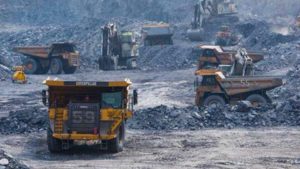Ghana’s Coming ‘White Gold’ Boom
Accra, Ghana//-Ghana’s birth as a lithium producer will coincide with a political transition with a new presidential administration, cabinet ministers, and parliament installed in January 2025.
- Advertisement -
All is set for Ghana to produce lithium (Li) also known as ‘white gold’ in commercial quantities in the third quarter of 2024. The discovery of this highly-demand resource which is hugely deposited in the Mankessim area of the Central Region, has once again given rise to mounting expectations among stakeholders regarding the socio-economic development potential of the budding industry.
Accra, Ghana//-Ghana’s birth as a lithium producer will coincide with a political transition with a new presidential administration, cabinet ministers, and parliament installed in January 2025.
- Advertisement -
The country’s lithium rush is anchored on significant deposits. It is reported that Ghana’s proven 180,000 tonnes of lithium reserves rank the country fourth place on the African continent behind DR Congo (3,000,000 tonnes), Mali (840,000 tonnes) and Zimbabwe (690,000 tonnes).
- Advertisement -
Currently, Australia is the premier producer of lithium worldwide while Bolivia has the largest proven reserves of 21 million metric tonnes.
Ghana’s current lithium hotspot, Ewoyaa lithium project in Mankessim in the Central Region which is being developed by Atlantic Lithium, a leading lithium exploration and development company based in Australia is expected to be the first lithium-producing mine in Ghana, and West Africa as a whole.
Similar deposits have been discovered in the Central, Western and Volta regions so far. Geologists have hinted that more discoveries could be made if comprehensive exploration work is done in the remaining 13 regions of the West African country.
Lithium which is dubbed ‘white gold’ due to its soft, silvery-white look was first discovered in 1962 in the Yenku Forest Reserve on the west coast of Accra.
It was not until May 2017 that IronRidge Resources – now Atlantic Lithium – secured exclusive rights to the site. While the country’s discovery of lithium in commercial quantities was widely publicised in 2018, creating excitement among stakeholders and the international community.
The Ewoyaa lithium project
The project according to officials is focused on exploiting the Ewoyaa, Abonko and Kaampakrom lithium spodumene pegmatite deposits in western Ghana.
First production of lithium concentrate from the mine is expected in the second quarter of 2025. Atlantic Lithium completed a pre-feasibility study (PFS) for the project in September 2022.
The definitive feasibility study (DFS) for the project was announced in June 2023, which outlined a 2.7 million tonnes per annum (mtpa) spodumene mining operation over 12 years of the mine life.
The Ewoyaa lithium project is located approximately 100km south-west of Ghana’s capital city Accra. Its area covers two contiguous licences, namely Mankessim (RL 3/55) and Mankessim South (PL3/109).
The Mankessim licence area lies within the Birimian Supergroup, a Proterozoic volcano-sedimentary basin in western Ghana.
The project’s spodumene-bearing lithium mineralisation occurs as sub-vertical bodies within two dominant pegmatite trends, namely Ewoyaa and Abonko.
The Ewoyaa lithium project is estimated to hold 25.6 million tonnes (mt) of probable ore grading 1.22% lithium oxide (Li₂O), as of June 2023.
The project will utilise conventional open-pit mining methods involving drill, blast, load, and haul operations due to the shallow nature of the ore body. Mining operations will be contract-based and supervised by the Atlantic Lithium management team.
The Ewoyaa project site is accessible from Accra via the Accra-Cape Coast-Takoradi highway, which runs along the southern boundary of the project area.
The raw water requirement for the project is estimated to be 24.1m³/h, which will be met through passive pit inflows, runoff inflows to the water storage dam and tailings storage facility, along with a pump and pipeline system from Lake Agege.
Project funding and offtake agreement
Atlantic Lithium secured project development funding via an offtake agreement with Piedmont Lithium in August 2021.
Piedmont Lithium, which owns a 9.4% equity interest in Atlantic Lithium, agreed to offtake 50% of the Ewoyaa project’s annual spodumene concentrate output for conversion into lithium hydroxide as part of its Tennessee lithium project, which is proposed to be in Etowah, Tennessee, US.
Piedmont also secured a 50% interest in Atlantic Lithium’s spodumene projects in Ghana through the same offtake agreement.
Contractors
Consulting firm Ashmore Advisory provided the mineral resource estimates while SRK Consulting conducted geotechnical, hydrological and hydrogeological studies for the project.
Mining Focus Consultants provided mine engineering services and was also responsible for the mining study as part of the DFS while Trinol was engaged in metallurgical test works.
The process plant engineering, metallurgy and crushing assessment was provided by DRA South Africa, a subsidiary of DRA Global.
Site geotechnical studies and tailings storage facility and water storage dam assessments were provided by Geocrest & Associates and REC Engineering.
DRA, Atlantic Lithium, ACC Logistics, Bollore Africa, and Glen Falloch Consulting estimated the project’s operating cost while Zivvo analysed the project risks and opportunities.
The processing plant front-end engineering design (FEED) contract for the project was awarded to Primero Group (Primero), an engineering company, in December 2022.
From agro through oil to lithium economy
Cocoa has been the live wire of the Ghanaian economy since the country’s independence in 1957. It has been a significant contributor to Ghana’s gross domestic product (GDP) and a consistent source of foreign exchange for the country.
To begin with, Ghana approved a green-minerals policy to help manage the exploitation and production of lithium, a step toward tapping into the multibillion-dollar global industry.
The country’s minister for Lands and Natural Resources, Samuel Jinapor recently disclosed that the cabinet approved the policy document on July 27 this year.
The policy document, according to him, is expected to be passed by parliament before the end of the year and will provide clear guidelines and a fiscal regime for mining so-called green minerals in a manner that ensures Ghana derives as much benefit as possible from its resources.
“Ghana is seeking to operate at a level that makes the best out of the resource as much as practical,” Jinapor said on August 3, 2023, in Accra.
- Advertisement -
“Ghana’s Green Minerals Policy as approved by cabinet demands that not a single volume of lithium produced in this country will be allowed to be exported in its raw state.”
Ghana is Africa’s biggest gold producer and has deposits of other so-called green minerals including manganese, graphite, and cobalt, Jinapor said.
The development of the lithium industry in Ghana comes as Western governments race to secure supplies of critical minerals needed for the transition to clean energy.
“Now we have a national policy on exploitation, management, and regulation of Ghana’s green minerals, there may be some tweaks to improve the policy as parliament works to approve and inculcate it into the nation’s mining policy document,” the minister said recently.
So, the government is putting together the architect and policies to ensure the smooth take off of the country’s coming lithium-based industry.
When the lithium is poured hopefully by 2025, the country would have exploited the resource and changed the country’s economic paradigm-so that its dependence on traditional raw material exports of cocoa, gold, timber, and oil and gas.
For instance, Ghana’s three main export products are gold (37.5%), mineral fuels and oils (30.6%), and cocoa beans and products (12.4%), which constitute over 80.0 percent of all exports, according to Ghana 2022 Trade Vulnerability Report.
Ghana’s trade relations, both exports and imports, are predominantly with Europe, constituting more than a third of all exports (35.9%) and imports (39.2%).
This is followed by Asia, with 28.5 percent of all exports and 37.2 percent of imports. The value of imports is higher than the value of exports for all continents except for Africa and North America: exports to other African countries are GH₵13.2 billion higher than imports, and the difference is GH₵6.8 billion for North America.
The partner country is unknown for less than 0.5% of transactions; e.g., for the fueling of aircrafts.
About half (50.4%) of all Ghana’s exports to Europe goes to Switzerland, followed by 13.0 percent to the Netherlands and 8.9 percent to Italy. China (44.3%) and India (33.9%) together make up more than three quarters (78.2%) of all Ghana’s exports to the Asian continent, the report said.
In Africa, 80. 6 percent of Ghana’s exports go to four countries: South Africa (51.3%), followed by Ghana’s neighbouring countries Burkina Faso (15.7%), Côte d’Ivoire (8.2%) and Togo (5.4%). For North America, 71.4 percent of all exports go to Canada, it added.
Ghana which has a long history of natural resource production dating back to pre-colonial times-gold, bauxite, manganese, diamonds and recent oil and gas, the discovery of lithium came as no surprise to many.
It is projected that Ghana will generate about $4.8 billion over the life of the mine (LOM) based on a five per cent carried interest in the project.
The carried interest of five per cent is like the Government’s interest in other decades-old mineral mining agreements which have failed to yield notable benefits to the state or surrounding communities thus far.
Employment
In the area of employment, over thousands of people in and out the lithium project area would be employed in the coming lithium industry.
Many are currently engaged in the field development while waiting for the actual commercial production of the ‘white gold’ which begins in 2025.
Indeed, the majority of Ghanaians would benefit directly and indirectly from the lithium industry, whereas the communities that the Atlantic Lithium is operating in are currently receiving massive corporate social investments.
What is lithium and its uses
Lithium (Li) is the lightest of all metals, particularly belonging to the group of elements called alkali metals. It’s highly reactive or always wants to shed electrons. It also has the lowest density and can store a lot of energy in a small space, making it ideal for making batteries.
Lithium is a rare earth mineral that has gained prominence in recent times owing to the critical role it plays in the growing electric vehicle (EV) revolution which relies on lithium-ion (Li-ion) batteries, according to experts.
It is also widely used in the production of several electronic devices such as smartphones and computers.
Hence, Li-ion batteries will be more in demand as mobile electronic devices such as smartphones, tablets, laptops, and other wearable devices proliferate with growing access to the Internet.
Demand for battery-grade lithium will grow sharply in coming years as the EV and energy storage sectors continue to rise. Lithium-ion batteries are a vital component in transitioning to a low-carbon global economy.
With EVs representing 10% of total global car sales, battery makers struggle to source more lithium. So, Ghana will cash in on its coming lithium boom.
EV carmakers prefer lithium-ion batteries as they’re lightweight and can be quickly recharged.
Management of lithium wealth
Although lithium-generated wealth like other natural resources can create major opportunities for social and economic development, it can at the same time lead to many problems if mismanaged.
Abuses and misallocations of the lithium resource windfalls can lead to economic distortions, social and political instability and at times armed conflicts. Although no lithium producing country has exhibited this symptom, countries should not lose sight of this.
Impact on local communities
The production of lithium would induce economic, social, environment and cultural changes on coastal communities that become the principal staging areas for the lithium activities.
The term “social issues” is usually used to describe the range of impacts both positive and negative a project may have on its social environment and vice-versa.
The social environment encompasses local people (including their norms, values, beliefs, and culture), both their environment and economy.
Source:africaneyereport.com
- Advertisement -


